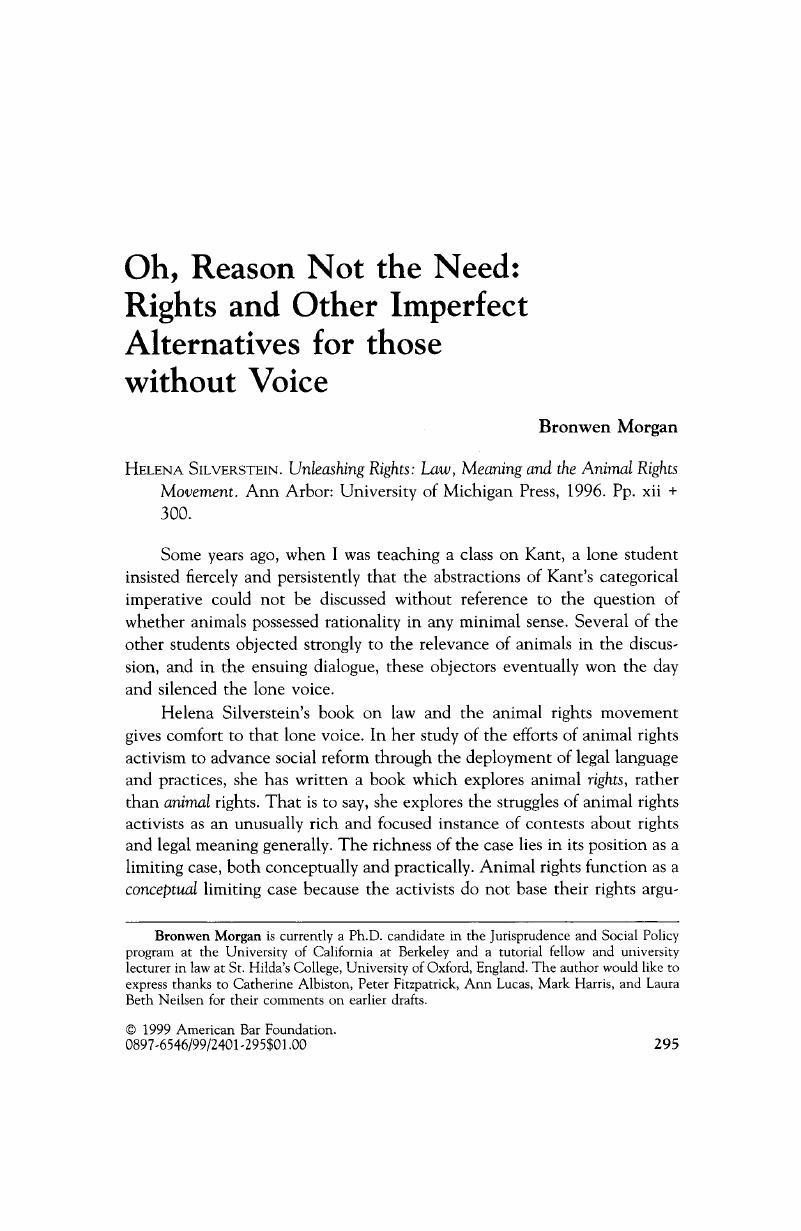No CrossRef data available.
Article contents
Oh, Reason Not the Need: Rights and Other Imperfect Alternatives for those without Voice
Published online by Cambridge University Press: 27 December 2018
Abstract
An abstract is not available for this content so a preview has been provided. Please use the Get access link above for information on how to access this content.

- Type
- Review Essay
- Information
- Copyright
- Copyright © American Bar Foundation, 1999
References
Alston, P., Parker, S., and Seymour, J.
1992. Children, Rights and the Law. Oxford, England: Clarendon Press.Google Scholar
Bohte, Roy Flemming John, and Wood, Dan. 1998. One Voice among Many: The Supreme Court's Influence on Attentiveness to Issues in the U.S., 1947–1992. In Leveraging the Law: Using the Courts to Achieve Social Change, ed. Schultz, David A.
New York: Peter Lang.Google Scholar
Bumiller, Kristin. 1988. The Civil Rights Society: The Social Construction of Victims. Baltimore: Johns Hopkins University Press.Google Scholar
Burca, de, Grainne, . 1995. The Language of Rights and European Integration. In New Legal Dynamics of European Union, ed. Shaw, Josephine and More, Gillian. New York: Clarendon Press.Google Scholar
Cobb, Sara. 1997. The Domestication of Violence in Mediation. Law and Society Review
31:397–440.Google Scholar
Dworkin, Ronald. 1977. Taking Rights Seriously. Cambridge, Mass.: Harvard University Press.Google Scholar
Fitzpatrick, Peter. 1997. Distant Relations: The New Constructionism in Critical and Socio-Legal Studies. In Socio-Legal Studies, ed. Thomas, Philip. Aldershot, , England: Dartmouth.Google Scholar
Fraser, Nancy. 1989. Talking about Needs: Interpretive Contests as Political Conflicts in Welfare-State Societies. Ethics
99:291–313.Google Scholar
Fraser, Nancy. 1997. Justice Interruptus: Critical Reflections on the “Postsocialist” Condition. New York: Routledge.Google Scholar
Friedman, Laurence. 1990. The Republic of Choice: Law, Authority and Culture. Cambridge, Mass.: Harvard University Press.Google Scholar
Friedman, Laurence. 1998. Review of Liberty, Equality and Justice: Civil rights, Women's Rights and the Regulation of Business, 1865–1932, by Ross Evans Paulson. Law and Politics Book Review [electronic journal at http://www.unt.edu/lpbr/] 2(9):100–102.Google Scholar
Gabel, Peter, and Kennedy, Duncan. 1984- Roll over Beethoven. Stanford Law Review
36:1–55.Google Scholar
Glendon, Mary Ann. 1991. Rights Talk: The Impoverishment of Political Discourse. New York: Free Press.Google Scholar
Harris, Mark. 1997. Taking Indivisibility Seriously: Why We Should Interpret Human Rights. Paper presented at the Annual Meeting of the Law and Society Association, 7 June, St. Louis, Missouri. On file with author.Google Scholar
Hartmann, Heidi. 1981. The Unhappy Marriage of Marxism and Feminism: Towards a More Progressive Union. In Women and Revolution: A Discussion of the Unhappy Marriage of Marxism and Feminism, ed. Sargent, Lydia. London: Pluto Press.Google Scholar
Hooks, Bell. 1981. Ain't I a Woman: Black Women and Feminism. Boston: South End Press.Google Scholar
Kagan, Robert. 1994
Do Lawyers Cause Adversarial Legalism? A Preliminary Inquiry. Law and Social Inquiry
19:1–62.Google Scholar
Komesar, Neil. 1994- Imperfect Alternatives: Choosing Institutions in Law, Economics and Public Policy. Chicago: University of Chicago Press.Google Scholar
Law and Social Inquiry.
1992. Review Section Symposium: The Supreme Court and Social Change. Law and Social Inquiry
17:715–78.Google Scholar
Law and Society Review
. 1992. Presidential Address by Joel Handler and Comments. Law and Society Review
26:697–819.Google Scholar
Matsuda, Mari. 1987. Looking to the Bottom: Critical Legal Studies and Reparation. Harvard Civil Rights and Civil Liberties Law Review
22:323–99.Google Scholar
McCann, Michael. 1994. Rights at Work: Pay Equity and the Politics of Legal Mobilization. Chicago: University of Chicago Press.Google Scholar
McCann, Michael. 1996. Causal versus Constitutive Explanations (or, on the Difficulty of Being So Positive.). Law and Social Inquiry
21:457–82.Google Scholar
McCann, Michael. 1998. Review of Civic Ideals: Conflicting Visions of Citizenship in U.S. History, by Rogers. S. Smith. Law and Politics Book Review [electronic journal at http://www.unt.edu/lpbr/] 2(9):159–63.Google Scholar
Milner, Neal. 1989. The Denigration of Rights and the Persistence of Rights Talk: A Cultural Portrait. Law and Social Inquiry
14:631–75.Google Scholar
Minow, Martha. 1987. Interpreting Rights: An Essay for Robert Cover. Yale Law Journal
96:1860–1915.Google Scholar
Minow, Martha. 1990. Making All the Difference: Inclusion, Exclusion and American Law. Ithaca, N.Y.: Cornell University Press.Google Scholar
Mouffe, Chantal. 1992. Democratic Citizenship and the Political Community. In Dimensions of Radical Democracy: Pluralism, Citizenship, Community, ed. Mouffe, Chantal. London: Verso.Google Scholar
Rose, Nikolas. 1985. Unreasonable Rights: Mental Illness and the Limits of the Law. Journal of Law and Society
12:199–218.Google Scholar
Rosenberg, Gerald. 1991. The Hollow Hope: Can Courts Bring about Social Change? Chicago: University of Chicago Press.Google Scholar
Rosenberg, Gerald. 1996. Positivism, Interpretation, and the Study of Law. Law and Social Inquiry
21:435–55.Google Scholar
Sandel, Michael. 1982. Liberalism and the Limits of Justice. New York: Cambridge University Press.Google Scholar
Sarat, Austin, and Kearns, Thomas, eds. 1995. Identities, Politics and Rights. Ann Arbor: University of Michigan Press.Google Scholar
Sarat, Austin, and Kearns, Thomas, eds. 1996. Legal Rights: Historical and Philosophical Perspectives. Ann Arbor: University of Michigan Press.Google Scholar
Scheiber, Harry N.
1998. Historical Memory, Cultural Claims, and Environmental Ethics in the Jurisprudence of Whaling Regulation. Ocean and Coast Management
38:5–40.Google Scholar
Schneider, Elizabeth. 1986. The Dialectic of Rights and Politics: Perspectives from the Women's Movement. New York University Law Review
61:589–652.Google Scholar
Stychin, Carl. 1995. Law's Desire: Sexuality and the Limits of Justice. London: Routledge.Google Scholar
Tushnet, Mark. 1987. The NAACP's Legal Strategy against Segregated Education, 1925–1952. Chapel Hill: University of North Carolina Press.Google Scholar
Waldron, Jeremy. 1993. When Justice Replaces Affection: The Need for Rights. In Liberal Rights: Collected Papers 1981–1991, ed. Waldron, Jeremy. New York: Cambridge University Press.Google Scholar
Waldron, Jeremy. 1996. Rights and Needs: The Myth of Disjunction. In Sarat and Kearns 1996.Google Scholar
Williams, Patricia. 1991. The Alchemy of Race and Rights: Diary of a Law Professor. Cambridge, Mass.: Harvard University Press.Google Scholar
Wilson, Richard, ed. 1997. Human Rights, Culture and Context: Anthropological Perspectives. London: Pluto Press.Google Scholar


